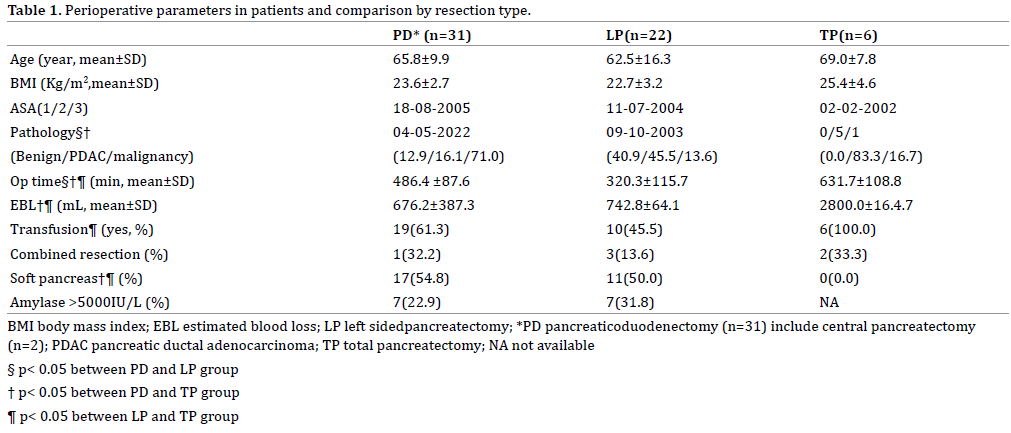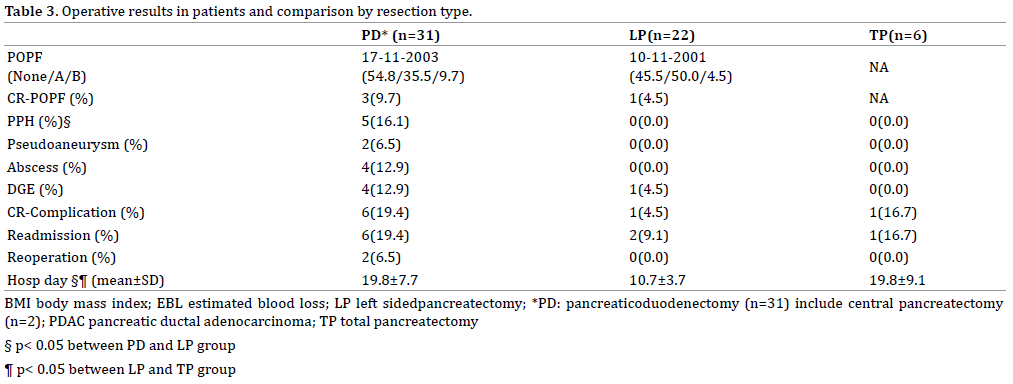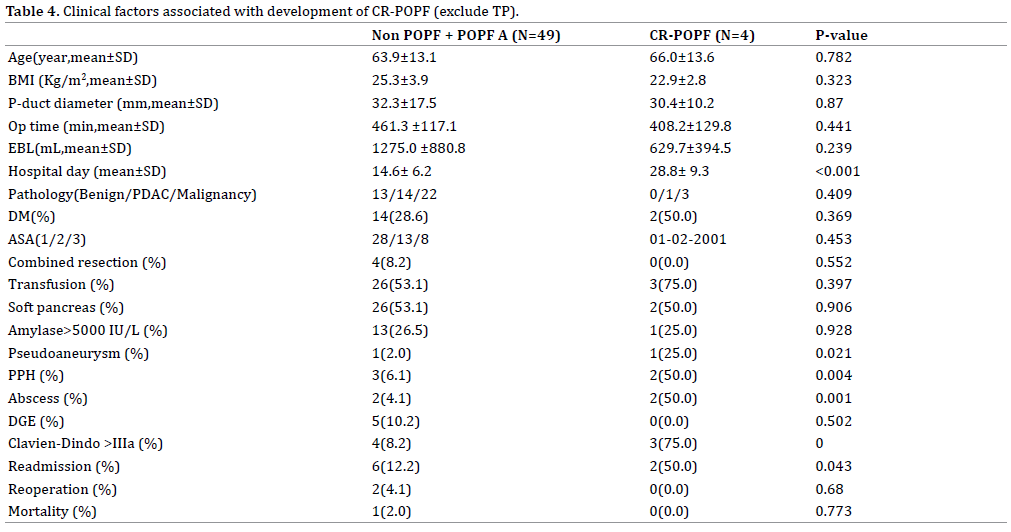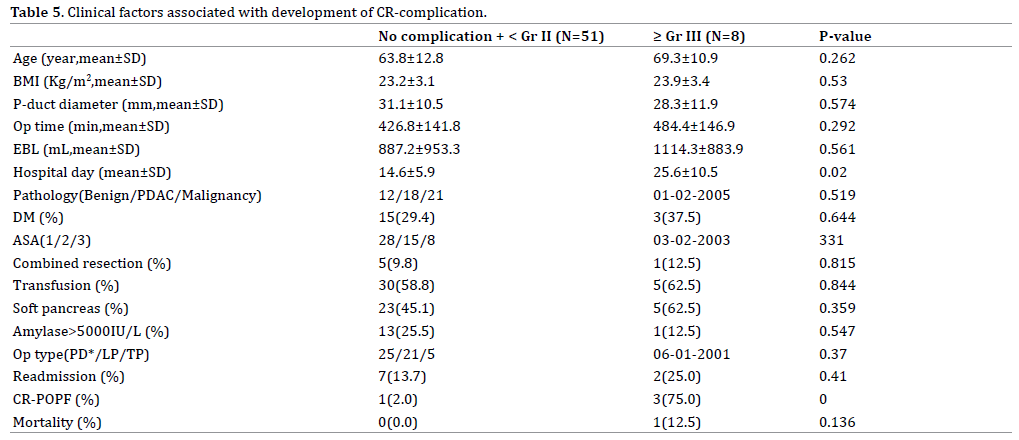Original Article - (2018) Volume 19, Issue 1
Department of Surgery, College of Medicine, The Catholic University of Korea, Yeouido St. Mary’s Hospital, Seoul, Korea
Received November 05th, 2017 - Accepted December 22nd, 2017
Introduction The relationship between hospital procedure volume and surgical outcomes has been a topic of considerable interest. Pancreatic resections are complex and associated with a high risk of complications. Hospitals with a higher volume of pancreatic resections have been shown to have better post-operative outcomes than lower-volume hospitals. However, pancreatic resections previously reserved for severe complication has evolved into a common and safe procedure performed by many surgeons today. This study aimed to investigate outcome of pancreatic resections in low volume center through short term surgical results. Methods 59 patients with pancreatic resections were enrolled during a 3-year periods. Clinically relavent complications were defined as Clavien- Dindo grade III-V complications. Pancreatic fistula and post-pancreatectomy hemorrhage were scored and graded according to standard international consensus definitions. Clinically significant PF was defined grade B or C. The main outcome measures in this study were rates of CR-POPF, clinically significant complications, 90-day mortality, 90-day readmission and reoperation. Results There was 29 pancreaticoduodenectomy, 22 Left sided pancreatectomy, 6 total pancreatectomy, and 2 central pancreatectomy. There was one in hospital mortality (1.67%). Overall CR-POPF rate was 6.6% (n=4), PPH rate was 8.3% (n=5) and CR-complication rate was 13.3% (n=8). 8 patients (13.3%) were hospitalized again after index discharge and 2 patients (3.3%) had to get surgery again. There were no significant differences in CR-complication rates (20.7% vs. 4.5%, vs. 16.7% p=0.37), CR-POPF (10.3% vs. 4.5% vs. 0% p=0.68), or reoperation rates (6.9% vs. 0% vs. 0% p=0.54) among pancreaticoduodenectomy, left sided pancreatectomy and TP groups, respectively. CR-complication was associated with more CR-POPF (p=0.0001). Conclusion Pancreatic resections can be achieved at a low-volume hospital with good results, but longer and more observation will be needed for acceptable.
Pancreas; Pancreatic Fistula
CR Clinically relavent; LP Left sided pancreatectomy; PD pancreaticoduodenectomy; PF Pancreatic fistula; PPH postpancreatectomy hemorrhage; PR Pancreatic resections
The association between hospital procedure volume and their surgical outcomes has been a medical and social concerns. This volume-outcome relationship has been studied extensively, and considerable evidence seems to support it for a variety of surgical procedures [1, 2, 3, 4, 5, 6].
Pancreatic resections (PR) are complex and associated with a high risk of complications. Birkmeyer et al. reported that mortality of pancreatoduodenectomy (PD) in lowvolume (LV) hospitals can be three- to four-fold greater than in high-volume (HV) hospitals [1]. Hospitals with a HV of pancreatectomies have been shown to have better post-operative outcomes than LV hospitals [7, 8, 9, 10, 11]. Therefore, there is growing trend toward referral of patients to HV hospitals [12]. Moreover, a new legislative reform was introduced defining a threshold of pancreatic resections in Germany [13]. The National Cancer Policy Board of USA has recommended selective referral to HV centers for pancreatectomy, this procedures with the strongest volume-mortality relationships [14]. Both hospital and surgeon procedure volume predicted mortality [15].
However, PR previously reserved for severe complication and carried a high mortality, has evolved into a common and safe procedure performed by many surgeons today. Major PR can be performed safely at community hospitals [16]. This study was undertaken to investigate outcome of PR in a LV hospital through short term surgical results.
Between March 2012 and June 2016, 68 patients underwent PR at Yeouido St. Mary’s Hospital in Seoul, Korea. Among them, 8 patients were excluded who underwent unplanned and planned PR by Gastrointestinal surgeon during same periods. Consecutive 59 patients underwent PR for pancreatic disease by single HBP Surgeon (KY.P), including periampullary malignancy and various pancreatic diseases at a LV hospital.
PD was performed using conventional type or pylorus-preserving. Almost of pancreaticoenterostomy was pancreaticojejunostomy with external pancreatic stent drainage. When jejunal diameter was smaller than pancreas stump thickness, pancreaticogastrostomy was selected instead of pancreaticojejunostomy. Left sided pancreatectomy (LP) included distal pancreatectomy or subtotal pancreatectomy which was defined as pancreas stump was located at porto-splenic vein junction level. In case of pancreatic ductal adenocarcinoma (PDAC), we performed radical antegrade modular pancreaticosplenectomy [17]. When tumor was suspected to benign, LP was performed under laparoscopic approach with or without splenectomy. Total pancreatectomy (TP) was performed when entire pancreas was involved pathology or pancreas neck margin revealed existence of PDAC cell on frozen biopsy during pancreatectomy. Central pancreatectomy (CP) was performed when benign tumor was located on neck or body area and distal remnant pancreas was inserted into stomach body.
We retrospectively analyze the demographics, resection types, pathologic diagnosis, and clinical outcome including the postoperative complication. We analyzed PD group including 2 patients with CP because of existence of pancreaticoenterostomy.
All patients received octreotide routinely given subcutaneously (100 μg every 8 hour for 7 days). The volume of fluid drained from the peripancreatic drains and that drained from the pancreatic duct were measured daily, and serum and drain fluid amylase levels were measured on postoperative days 1, 3, 5, and 7. A computed tomography scan was performed on postoperative day 7, and if there was no evidence of leakage or fluid collection, the peripancreatic drains were removed.
Postoperative outcomes were followed until 90 days after surgery and were graded according to the Clavien- Dindo system [18]. A final overall patient complication grade was given to the highest-rated complication grade experienced by patients. Clinically relavent (CR) complications were defined as grade III-V complications. Post-operative pancreatic fstula (POPF) [19] and postpanceatectomy hemorrhage (PPH) [20] were scored and graded according to standard international consensus definitions. Clinical relavent (CR) PF was defined grade B or C. Delayed gastric emptying (DGE) was defined as the need for nasogastric decompression beyond the 10th postoperative days. Length of stay (LOS) was recorded and was defined as postoperative day 1 through day of discharge. Surgical site infection (SSI), intra abdominal abscess and pneumonia were included postoperative complication in this study. Readmission to any hospital was defined as any unplanned admission and was tracked for all patients through 90 days after surgery. Reoperation was defined as any unplanned operation within 90 days of the primary pancreatic resection.
All results are presented as mean (range). Statistical analyses were performed with SPSS for Windows, version 16.0 (SPSS Inc, Chicago, Illinois). Univariate analyses were conducted with T-test, Mann-Whitney, chi-square tests as appropriate. All tests were 2 sided, and P<0.05 was considered statistically significant.
Patients
During the 51-months study period, a total of 59 patients underwent a formal pancreatic resection by the single surgeon included in this study. There were 29 PD, 22 LP, 6 TP, and 2 CP. The most common diagnosis prompting an operation was periampullary carcinoma excluding PDAC (n=22, 37.3%), followed by PDAC comprising 30.5% (n=18), cystic neoplasms (including intraductal papillary mucinous neoplasm; mucinous cystic neoplasm; serous cystadenoma; and solid pseudopapillary neoplasm) comprising 20.3% (n=12) and pancreatic neuroendocrine tumors comprising 11.9% (n=7).
Clinical Parameters According to Resection Type
There were no differences of age, body mass index, and American association of Anesthesiology risk among three resection types. Most of pathology for PD was periampullary neoplasm. 40.9% of LP (n=9) was performed for benign pancreas neoplasm and 45.5% (n=10) of LP was for PDAC. Almost of TP (83.3%, n=5) was performed for PDAC. Operation time was significantly longer in PD and TP than LP and TP was most time- consuming procedure among three groups (mean 631 minute). There were no differences of rate of transfusion, rate of combined adjacent organ resection, proportion of soft pancreas and above 5000IU/ml of drain amylase level on post-operative one day among three groups. Above results were described in Table 1.

Postoperative Complication
There was one in hospital mortality (1.67%) due to PPH derived from gastroduodenal artery pseudoaneurysm caused by POPF. Mortality case was 78-year old man who had diagnosed mid CBD cancer and underwent PD. Clavien-Dindo grade I complication contained 4 surgical site infection and grade II complication were 4 DGE. CRcomplication rate was 13.3% (n=8) including 5 PPH (2 pseudoaneurysm, 2 gastric ulcer bleeding, and 1 omental bleeding), 3 abscess, 1 pulmonary effusion (Table 2). There were no significant differences in CR-complication rates (20.7% vs. 4.5%, vs. 16.7% p=0.37) according to operation type (PD vs. LP vs. TP).

Postoperative Pancreatic Fistula
Grade A POPF was observed 11 (35.5%) patients who underwent PD and to 11 (50.0%) patients underwent LP. Overall CR-POPF rate was 6.6% (n=4) including 3 occurrences in PD and one in LP (RAMPS). However, there was no significant differences of CR-POPF between resection type (PD vs. LP= 9.7% vs. 4.5% p=0.49) (Table 3).

Readmission and reoperation
8 patients (13.3%) were hospitalized again after index discharge. The cause of readmission was 4 poor oral intakes, 1 poor glucose control, 1 hematemesis, and 2 ileus. Two patients (3.3%) had to undergo surgery again due to intra-abdominal PPH. One patient underwent relaparotomy owing to omental bleeding which was easily controlled by bleeder ligation. Another patient was mentioned above paragraph and he expired 10 days after relaparotomy due to multi-organ failure. Reoperation rates of PD was 6.9% (n=2) and there was no reoperation after LP and TP (p=0.64).
Clinical factors associated with development of CRPOPF and CR-complication
CR-POPF was associated with CR-complication (p<0.001), pseudoaneurysm (p=0.021), PPH (P=0.04), intra-abdominal abscess (p=0.001), and readmission (p=0.043) (Table 4). CR-complication was associated with CR-POPF and longer LOS (P<0.001) (Table 5).


The aim of the present study was to investigate the result of PR at a LV institution. To accomplish this aim, we evaluated short term surgical result of all type of PR using various parameters. Despite of lower number of entire PR, our results demonstrate that morbidity and mortality were comparable those of previous HV centers in literatures. Our 90-day hospital mortality was 1.67%, surgical complication above Clavien-Dindo IIIa rate was 13.3%, 3.3 % reoperation rate and overall CR-POPF rate was 6.6%.
In general, surgical outcome of PR had been focused on large volume centers. It means PR result of LV center overlooked so far. Although it was single center and single surgeon experience for PR observed short term period, it is shed light on result of PR at a LV institution. There was only one study regarding PR in LV center with rough data [16].
In terms of PD, evidence showing better outcomes in HV centers was well established. Recent systemic analysis [12] demonstrated strong evidence for inverse association between higher hospital volume and lower mortality after PD. In contrast, Schell et al. [21] showed that LV hospitals were able to obtain results comparable to those of HV providers if expertise and care pathways were imported. Investigation based on nationwide administrative data reported that hospital procedure volume is not a significant predictor of mortality for the performance of PR [22]. Pawlik et al. [15] revealed the analysis supporting HV expertise in one area of hepatobiliary and pancreas surgery does not translate into improved outcomes for related procedures.
Two decades ago, there was initial consensus regarding hospital experience is particularly important with PD, and patients considering this procedure should be given the option of care at a HV referral center [1]. Recent two studies performed by Japanese and Swedish groups insisted of evidence regarding centralization of PD in a national healthcare system [23, 24]. Equally, participation in regional quality collaboratives by LV hospitals can attenuate the volume outcome relationship for pancreatic surgery. Continued work in collaboratives with an emphasis on technical and intraoperative aspects of care may improve overall quality of care [25].
However, the optimal cutoff values for defining HV hospital are currently under debate [12]. The Leapfrog Group volume originally proposed cutoffs 11 PD per year [26]. Previously published definitions of HV hospitals showed ranging from 10 to 80 PD/year, with the majority using a definition between 10 and 30 PD/year [27, 28, 29]. Systematic review suggested that variations in HV cutoff values across studies majorly influenced the overall heterogeneity of results. Accordingly, criteria for PR volume might be debatable yet on the bases of previous literatures [12].
Our hospital has been teaching and academic University Hospital and average annual volume of PR has been ten to twenty since 2000 steadily. In this study, PR was performed by single surgeon who was trained in HV center performing annual PR might be over 200. After twoyear fellowship training, he worked at community hospital its average PR volume was under 10 yearly during three years and then moved to this University Hospital.
We believe that lower rate of CR-POPF in this study was up to tailored pancreaticoenterostomy according to risk for it. In previous study, we showed very lower rate of POPF following external drainage with modified pancreaticojejunostomy [30]. Also we performed pancreaticogastrostomy if pancreas texture was soft and pancreatic duct under 2 mm. With regard to LP, stump closure method has changed using thickest stapler since 2013 under laparoscopy to reduce POPF and kept closing the main duct and to reinforce whole stump during open surgery.
However, inherent limitation of very short period of study, we believe that the prolonged study period allows us to accurately ascertain the accurate result of ours through this method.
Recently, concern for improving surgical quality focused on “failure to rescue” which means mortality following complication [31]. Most previous research in understanding volume-mortality relationships has focused on the occurrence of complications [32, 33]. Differences in mortality between HV and LV hospitals are not associated with large differences in complication rates. Instead, these differences seem to be associated with the ability of a hospital to effectively rescue patients from complications. Strategies focusing on the timely recognition and management of complications once they occur may be essential to improve outcomes at LV hospitals [31]. We totally agree with this concept concerning a mortality case in this study depended on insufficient management of PPH in intensive care unit, inappropriate patient selection and multidisciplinary approach was lack.
Pawlik et al. [34] emphasized that improvement of mortality in LV hospital after PR seems to be related to a decreased FTR according to nationwide database. Accordingly, we will try to do best to improve FTR in future even in a LV hospital.
Interestingly, recent researches dealt with surgeon factor for PR. Schmidt et al. [35] demonstrated experienced surgeons had comparable outcomes irrespective of annual volume. Toomy et al. [36] reported that salutary benefits of undertaking PD at a HV hospital are transferred to a LV hospital when HV surgeons relocate and the "best" results follow HV surgeons. Surgeon in this study was trained at a HV institute performing PR over 200 per year and transferred to LV hospital. Italian study suggested that the surgeon experience together with selection of patients, team experience of LV hospital may be important factor for overcoming volume effect [37]. This point is very important to improve the short outcome of PR at a LV hospital, as we mentioned above reflecting our mortality case. Furthermore, sharing of operative techniques and perioperative care pathways, which has enabled the LV hospitals to develop a health care delivery system that resembles the large-volume hospital and achieves comparable results [22]. To improve and acquire acceptable result of PR, LV institution should make every effort that all above mentioned.
The limitation of the study is the short period of observation and the low number of case. From a clinical point of view, the manuscript would achieve more relevance if multiple low-volume centers were included.
In addition, oncologic outcome measurements should include 5-year and disease-free survival at a LV hospitals in next study.
PR can be achieved at a LV hospital with good results, but longer and more observation will be needed for acceptable.
None of the authors have any conflict of interest to disclose related to this article.